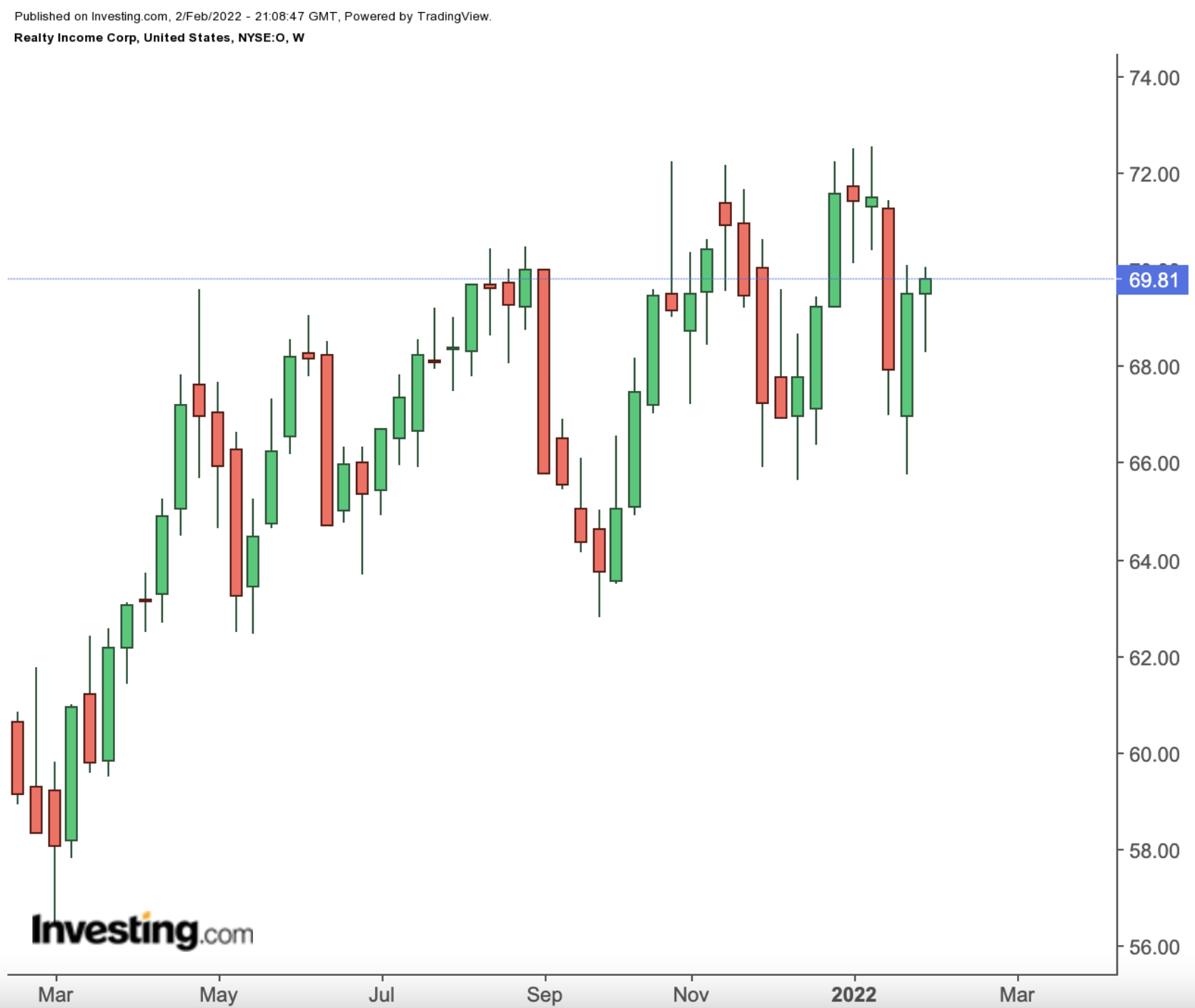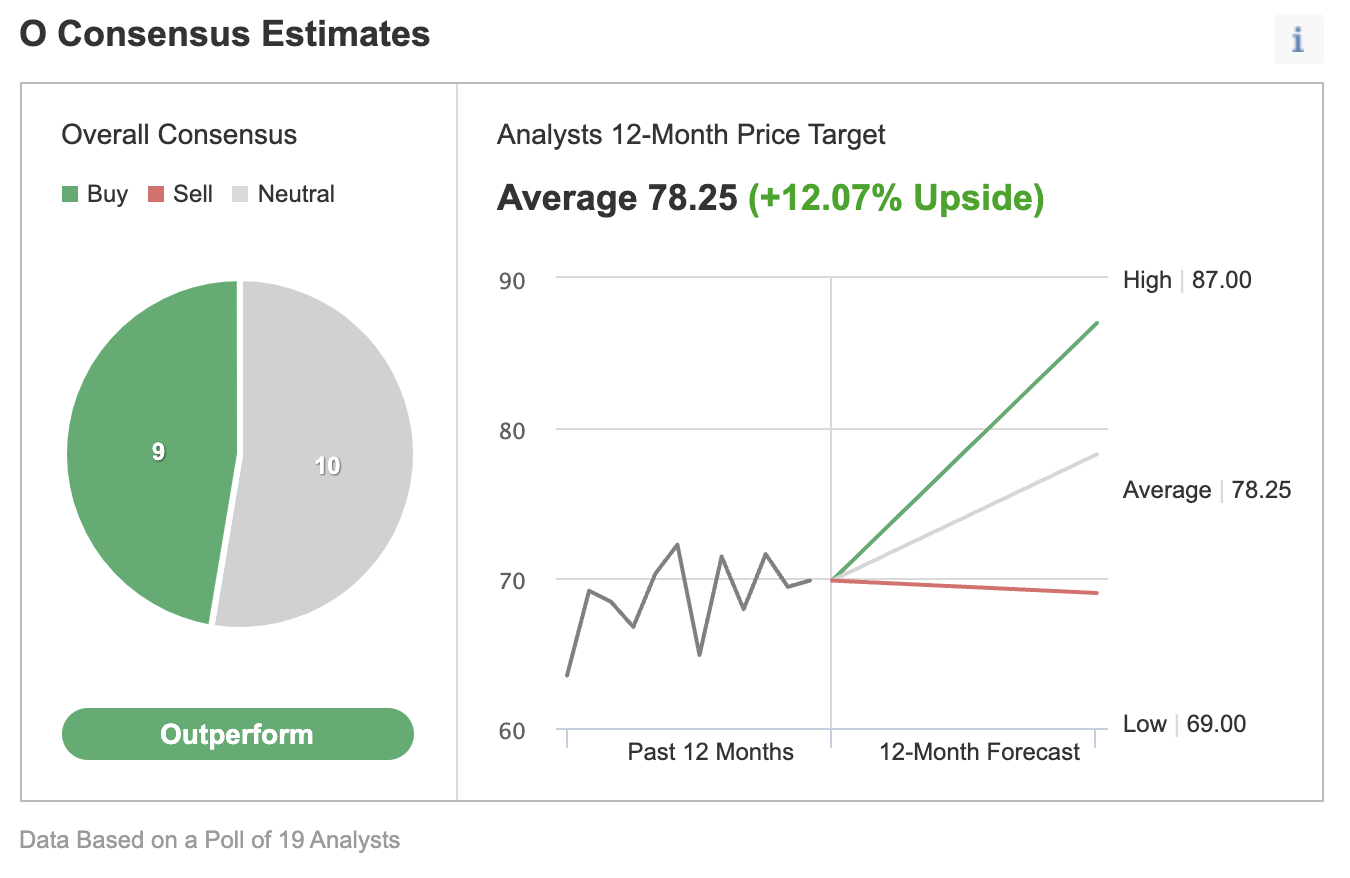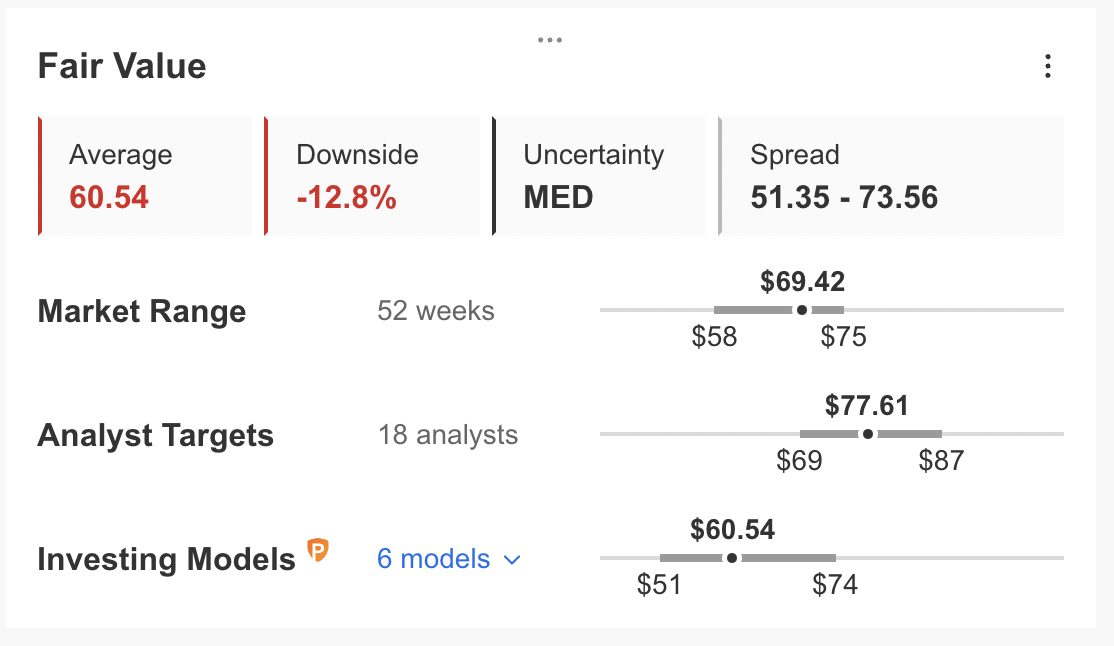- One of the largest net-lease REITs, O stock, is down more than 3% year to date.
- Realty Income will report quarterly metrics Feb. 22.
- Long-term investors could consider investing in O shares around $66.5 or below.
Shares of real estate investment trust (REIT) Realty Income (NYSE:O) have declined 3.3% since the beginning of the year. But O stock is still up about 18% in the past 52 weeks.

In comparison, the Dow Jones Equity REIT Index returned 22.8% in the past year, but is down 8.2% so far in 2022.
On Jan.13, O shares went over $72.5 to hit a record high. But since then, it has come under pressure and closed on Wednesday at $69.80. The stock’s 52-week range has been $56.43 - $72.55, while its market capitalization stands at $39.2 billion.
Realty Income currently has around 11,000 single-client commercial properties, primarily with long-term net-lease agreements. Its clients operate in scores of industries in the U.S. as well as the U.K. and Spain. At the same time, the weighted average remaining lease term for Realty Income clients is close to nine years and the portfolio occupancy stands at 98.8%.
Among its top tenants are AMC Entertainment Holdings (NYSE:AMC), Dollar General (NYSE:DG), FedEx (NYSE:FDX), Home Depot (NYSE:HD), Kroger (NYSE:KR), Walgreens Boots Alliance (NASDAQ:WBA) and Walmart (NYSE:WMT). Under their net lease agreements, these clients would typically be responsible for most of the expenses (like repairs and regular maintenance) of these properties.
Realty Income’s commercial real estate portfolio has historically provided dependable rental revenue. And, since by law REITs are required to pay out 90% of their taxable income to shareholders, Realty Income uses “The Monthly Dividend Company®" as its nickname, not to mention its investment proposition.
How Recent Quarterly Results Came In
Realty Income announced Q3 financials on Nov. 1. Revenue was $491.9 million, up 21% year-over-year. Net income came in at $135 million as compared with $22.9 million in Q3 2020. Similarly, diluted EPS was 34 cents versus 7 cents a year ago. Adjusted funds from operations (AFFO) per share increased 12.3% to 91 cents.
On the results, CEO Sumit Roy said:
“Our position as a global consolidator continues to build as we invested a record $3.78 billion year to date across three countries, including our debut transaction in continental Europe.”
The company is set to announce Q4 metrics Feb. 22 after the market close. Management expects the 2021 AFFO per share to be $3.55 - $3.60, representing 5.5% annual growth based on the midpoint. Meanwhile, 2022 AFFO per share guidance is $3.84 - $3.97, implying annual growth of 9.2%.
Prior to the release of the quarterly results, Realty Income stock was around $70. The stock on Jan. 13 saw an all-time high of $72.55. Now, it is trading around $69.80. The current price supports a dividend yield of more than 4.2%.
What To Expect From Realty Income Shares
Among 19 analysts polled via Investing.com, O stock has an “outperform" rating.

Source: Investing.com
Analysts also have a 12-month median price target of $78.25 for the stock, implying an increase of about 12% from current levels. The 12-month price range currently stands between $69 and $87.
However, according to a number of valuation models, like those that might consider P/E or P/S multiples or terminal values, the average fair value for Realty Income stock via InvestingPro is $60.54.

Source: InvestingPro
In other words, fundamental valuation suggests shares could decrease around 12%.
We can also look at Realty Income’s financial health as determined by ranking more than 100 factors against peers in the real estate sector.
In terms of growth, profit and price momentum, O scores 3 out of 5. But relative value stands at 1. As a result, its overall score of 3 points equals a ‘good’ performance ranking.
At present, Realty Income’s P/E, P/B and P/S ratios are 82.9x, 2.9x and 21.6x, respectively. In comparison, those metrics for its peers stand at 21.9x, 2.0x and 9.4x. This means O stock is richly valued compared with the industry average.
Although we like Realty Income for its business model, which includes monthly dividends as well as growth potential, most of the good news for Q4 might already be priced into the stock. Therefore, in the coming days, as the REIT gets ready to release Q4 financials, O shares could come under pressure.
We believe a decline toward $66.5 is possible. After such a potential drop, the stock would probably trade sideways for several weeks, before a new up-leg could begin.
Adding O Stock To Portfolios
Realty Income bulls who are not concerned about short-term volatility would consider buying into the declines. Their target price would be $78.25, the analysts’ price target.
Alternatively, investors could consider buying an exchange traded fund (ETF) that has O stock as a holding. Examples would include:
- Fundamental Income Net Lease Real Estate ETF (NYSE:NETL)
- The Real Estate Select Sector SPDR Fund (NYSE:XLRE)
- Invesco S&P 500® Equal Weight Real Estate ETF (NYSE:EWRE)
- Invesco S&P 500® High Dividend Low Volatility ETF (NYSE:SPHD)
Finally, those who are experienced with options strategies and believe there could be further declines in O shares might prefer to do a bear put spread.
Most option strategies are not suitable for most retail investors. Therefore, the following discussion is offered for educational purposes and not as an actual strategy to be followed by the average retail investor.
Bear Put Spread On Realty Income Stock
Current Price: $69.80
In a bear put spread, a trader has a long put with a higher strike price as well as a short put with a lower strike price. Both legs of the trade have the same underlying stock (i.e. Realty Income in this example) and the same expiration date.
The trader wants O stock to decline in price. However, in a bear put spread, both the potential profit and the potential loss levels are limited.
Here's an example:
For the first leg of this strategy, the trader might buy an at-the-money (ATM) or slightly out-of-the-money (OTM) put option, like the O Mar. 18 67.5-strike put option. This option is currently offered at $1.45. It would cost the trader $145 to own this put option, which expires in over a month and half.
For the second leg of this strategy, the trader sells a put, like the O Mar. 18 65-strike put option. This option’s current premium is $0.80. The option seller would receive $80, excluding trading commissions.
Maximum Risk
In our example, the maximum risk will be equal to the cost of the spread plus commissions. Here, the net cost of the spread is $0.65 ($1.45 – $0.80 = $0.65). For 100 shares, the maximum risk becomes $65.
The trader could easily lose this amount if the position is held to expiry and both legs expire worthless, i.e., if the O stock price at expiration is above the strike price of the long put (or $67.50 in our example).
Maximum Profit Potential
In a bear put spread, potential profit is limited to the difference between the two strike prices minus the net cost of the spread plus commissions.
So in our example, the difference between the strike prices is $2.50. And as we’ve seen above, the net cost of the spread is $0.65.
The maximum profit, therefore, is $1.85 per share. When we multiply it by 100 shares, the maximum profit for this option strategy comes to $185, less commissions.
The trader will realize this maximum profit if O stock price is at or below the strike price of the short put (lower strike) at expiration (or $65 in our example).
Break-Even Price At Expiration
At the break-even point, the trade will not gain or lose any money.
At expiration, the strike price of the long put (i.e., $67.50 in our example) minus the net premium paid (i.e., $0.65 here) would give us the break-even O price.
In our example: $67.50 − $0.65 = $66.85 (minus commissions).
Bottom Line
Realty Income is a stock that deserves to be on the watchlist of passive-income seekers. However, O shares are likely to be volatile in February as the REIT reports earnings toward the end of the month. Interested readers could consider buying the dip in O stock, especially if it declines about 5%-7% from current levels.
